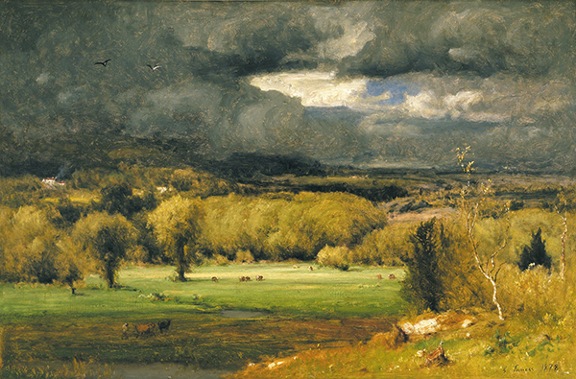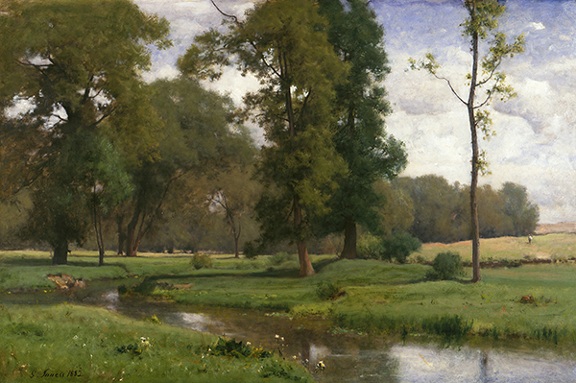June in a Painting: George Inness
One could call painter George Inness a “nature worshipper” because he was part of the Swedenborgian movement. One of the tenets of their faith was the fervent belief in seeing the supreme being in nature. Not a new concept—particularly among Japanese and Chinese landscape artists—nonetheless, one that Inness brilliantly demonstrated in his absolutely tip-top-gorgeous landscapes. Today, I will share a landscape Inness painted of the environs of Montclair, New Jersey. Can you tell Inness is one of my favorite landscape painters?
 |
| George Inness (1825–1894, U.S.), The Coming Storm, 1878. Oil on canvas, 20" x 28 ½" (50.8 x 72.4 cm). Image © 2024 Buffalo AKG Art Museum, Buffalo, NY. (AK-203) |
Throughout the 1870s and 1880s, Inness's style became increasingly painterly until, as in The Coming Storm, physical form almost dissolved into arrangements of misty color harmonies. Obviously, he sought not to reproduce the appearance of nature, but rather the poetic feelings nature inspired in him, which he transmitted to the viewer. This is sometimes referred to as his synthetic landscape style. Inness usually made several sketches and oil sketches of the subject, then produced the painting in his studio.
In 1885, late in the artist’s career, Inness moved to Montclair, where he would remain until his death in 1894. Manhattan is visible from some of the hills in the Eagle Rock Reservation near Montclair! During his time in Montclair, Inness honed his synthetic style of landscape painting. Storms were a favorite motif because they revealed both the beautiful and powerful aspects of nature, which were one and the same as God to Inness. The Coming Storm reveals loose brushwork—particularly in the clouds—that resemble the outdoor landscape studies produced by English Romantic landscape painter John Constable (1776–1837). The residual sunlight seen in the foreground is a subtle note that a period of light will follow the storm, much like death and resurrection in Christian or Swedenborg philosophy.
The first half of the 1800s in American painting was dominated by objective realism of the American landscape and scenes of everyday American life. Throughout the century, there continued to be a patriotic strain in American painting that rejected foreign influence, preferring "true" American art. Such sentiments were echoed in works of American literature such as Walt Whitman's (1819–1892) ode to all things American, Leaves of Grass.
The Hudson River School artists of the mid-1800s painted in a romantic-realist style that was influenced by British landscape painting. Their emphasis overall was unambiguous, unique American scenery. In the second half of the 1800s, some American artists again turned to Europe for inspiration, although they looked beyond Britain. Inness’s painting, too, started in the tight, realistic mode of the Hudson River School. Born in Newburgh, New York, and raised in Newark, New Jersey, Inness first studied painting under Hudson River School painter Regis Genoux (1816–1882). Inness opened his New York studio in 1845, then made his first trip to Europe in 1850 to Italy, and his second, in 1853, to France.
On his second Europe trip, Inness became enthralled with the painters of the Barbizon School, an artists’ community near Fontainebleau Forest outside of Paris. These artists focused primarily on landscape, emphasizing tonal qualities, true local color, loose brushwork, and a softness of form. On his return from France, these characteristics began to appear in Inness’s work. The Barbizon artist who seems to have had the greatest impact on his work was Théodore Rousseau (1812–1867).
In 1863, Inness left New York City for the artists’ colony in Englewood, New Jersey. Instead of concentrating on precise depiction of nature in a specific location, Inness softened details to explore coloristic and tonal harmonies. The anecdotal passages of Hudson River School landscapes gave way to the exploration of formal concerns. This emphasis initially increased after Inness learned about the Swedenborgian movement in the 1850s, a philosophy about nature developed by Swedish philosopher Emanuel Swedenborg (1688–1772), who stressed that the spiritual world was as tangible as the physical. Studying these philosophies the rest of his life, Inness’s landscapes began to reflect a personal vision of nature imbued with a spiritual well-being. He often accentuated this feeling with atmospheric lighting, preferring sunrise, sunset, storm, and moonlit compositions.
And here’s an artwork for the month of June!
 |
| George Inness, June, 1882. Oil on canvas, 40 3⁄16" x 55 3⁄16" (102.1 x 140.2 cm). Image © 2024 Brooklyn Museum. (BMA-41) |
Correlations to Davis programs: Explorations in Art 2E Grade 1: 3.5, 4.4; Explorations in Art 2E Grade 2: 1.1, 1.5, 1.6, 1.8, 1.9; Explorations in Art 2E Grade 3: 4.1, 4.3, 5.4; Explorations in Art 2E Grade 4: 1.7, 1.8, 1.9, 4.4, 4.5, 6.4; Explorations in Art 2E Grade 6: 2.1, 2.3; Experience Art: 4.1; A Community Connection 2E: 4.4; A Global Pursuit 2E: 7.2; A Personal Journey 2E: 5.1, 5.4; Discovering Art History 4E: 15.1

Comments